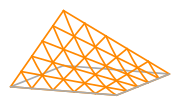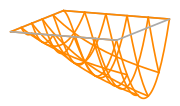an encyclopedia of finite element definitions
Degree 3 direct serendipity on a quadrilateral
◀ Back to direct serendipity definition page
- \(R\) is the reference quadrilateral. The following numbering of the subentities of the reference is used:
- Basis functions:

\(\displaystyle \phi_{0} = x y - x - y + 1\)
This DOF is associated with vertex 0 of the reference element.
This DOF is associated with vertex 0 of the reference element.
\(\displaystyle \phi_{1} = x \left(1 - y\right)\)
This DOF is associated with vertex 1 of the reference element.
This DOF is associated with vertex 1 of the reference element.
\(\displaystyle \phi_{2} = y \left(1 - x\right)\)
This DOF is associated with vertex 2 of the reference element.
This DOF is associated with vertex 2 of the reference element.
\(\displaystyle \phi_{4} = y \left(1 - y\right)\)
This DOF is associated with edge 1 of the reference element.
This DOF is associated with edge 1 of the reference element.
\(\displaystyle \phi_{5} = y \left(- y^{2} - y + 2\right)\)
This DOF is associated with edge 1 of the reference element.
This DOF is associated with edge 1 of the reference element.
\(\displaystyle \phi_{6} = y \left(x y - x - 2 y + 2\right)\)
This DOF is associated with edge 2 of the reference element.
This DOF is associated with edge 2 of the reference element.
\(\displaystyle \phi_{7} = \frac{4 x y \left(y^{2} + y - 2\right)}{x + 1}\)
This DOF is associated with edge 2 of the reference element.
This DOF is associated with edge 2 of the reference element.
\(\displaystyle \phi_{8} = x \left(1 - x\right)\)
This DOF is associated with edge 0 of the reference element.
This DOF is associated with edge 0 of the reference element.
\(\displaystyle \phi_{9} = x \left(- x^{2} - x + 2\right)\)
This DOF is associated with edge 0 of the reference element.
This DOF is associated with edge 0 of the reference element.
\(\displaystyle \phi_{10} = x \left(x y - 2 x - y + 2\right)\)
This DOF is associated with edge 3 of the reference element.
This DOF is associated with edge 3 of the reference element.











